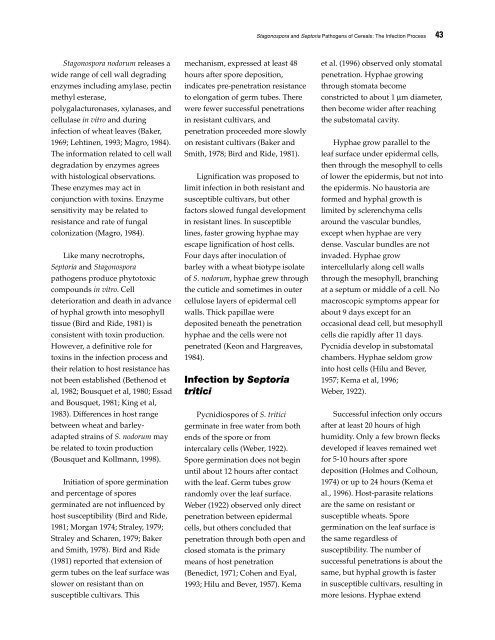Septoria and Stagonospora Diseases of Cereals - CIMMYT ...
Septoria and Stagonospora Diseases of Cereals - CIMMYT ...
Septoria and Stagonospora Diseases of Cereals - CIMMYT ...
You also want an ePaper? Increase the reach of your titles
YUMPU automatically turns print PDFs into web optimized ePapers that Google loves.
<strong>Stagonospora</strong> nodorum releases a<br />
wide range <strong>of</strong> cell wall degrading<br />
enzymes including amylase, pectin<br />
methyl esterase,<br />
polygalacturonases, xylanases, <strong>and</strong><br />
cellulase in vitro <strong>and</strong> during<br />
infection <strong>of</strong> wheat leaves (Baker,<br />
1969; Lehtinen, 1993; Magro, 1984).<br />
The information related to cell wall<br />
degradation by enzymes agrees<br />
with histological observations.<br />
These enzymes may act in<br />
conjunction with toxins. Enzyme<br />
sensitivity may be related to<br />
resistance <strong>and</strong> rate <strong>of</strong> fungal<br />
colonization (Magro, 1984).<br />
Like many necrotrophs,<br />
<strong>Septoria</strong> <strong>and</strong> <strong>Stagonospora</strong><br />
pathogens produce phytotoxic<br />
compounds in vitro. Cell<br />
deterioration <strong>and</strong> death in advance<br />
<strong>of</strong> hyphal growth into mesophyll<br />
tissue (Bird <strong>and</strong> Ride, 1981) is<br />
consistent with toxin production.<br />
However, a definitive role for<br />
toxins in the infection process <strong>and</strong><br />
their relation to host resistance has<br />
not been established (Bethenod et<br />
al, 1982; Bousquet et al, 1980; Essad<br />
<strong>and</strong> Bousquet, 1981; King et al,<br />
1983). Differences in host range<br />
between wheat <strong>and</strong> barleyadapted<br />
strains <strong>of</strong> S. nodorum may<br />
be related to toxin production<br />
(Bousquet <strong>and</strong> Kollmann, 1998).<br />
Initiation <strong>of</strong> spore germination<br />
<strong>and</strong> percentage <strong>of</strong> spores<br />
germinated are not influenced by<br />
host susceptibility (Bird <strong>and</strong> Ride,<br />
1981; Morgan 1974; Straley, 1979;<br />
Straley <strong>and</strong> Scharen, 1979; Baker<br />
<strong>and</strong> Smith, 1978). Bird <strong>and</strong> Ride<br />
(1981) reported that extension <strong>of</strong><br />
germ tubes on the leaf surface was<br />
slower on resistant than on<br />
susceptible cultivars. This<br />
mechanism, expressed at least 48<br />
hours after spore deposition,<br />
indicates pre-penetration resistance<br />
to elongation <strong>of</strong> germ tubes. There<br />
were fewer successful penetrations<br />
in resistant cultivars, <strong>and</strong><br />
penetration proceeded more slowly<br />
on resistant cultivars (Baker <strong>and</strong><br />
Smith, 1978; Bird <strong>and</strong> Ride, 1981).<br />
Lignification was proposed to<br />
limit infection in both resistant <strong>and</strong><br />
susceptible cultivars, but other<br />
factors slowed fungal development<br />
in resistant lines. In susceptible<br />
lines, faster growing hyphae may<br />
escape lignification <strong>of</strong> host cells.<br />
Four days after inoculation <strong>of</strong><br />
barley with a wheat biotype isolate<br />
<strong>of</strong> S. nodorum, hyphae grew through<br />
the cuticle <strong>and</strong> sometimes in outer<br />
cellulose layers <strong>of</strong> epidermal cell<br />
walls. Thick papillae were<br />
deposited beneath the penetration<br />
hyphae <strong>and</strong> the cells were not<br />
penetrated (Keon <strong>and</strong> Hargreaves,<br />
1984).<br />
Infection by <strong>Septoria</strong><br />
tritici<br />
Pycnidiospores <strong>of</strong> S. tritici<br />
germinate in free water from both<br />
ends <strong>of</strong> the spore or from<br />
intercalary cells (Weber, 1922).<br />
Spore germination does not begin<br />
until about 12 hours after contact<br />
with the leaf. Germ tubes grow<br />
r<strong>and</strong>omly over the leaf surface.<br />
Weber (1922) observed only direct<br />
penetration between epidermal<br />
cells, but others concluded that<br />
penetration through both open <strong>and</strong><br />
closed stomata is the primary<br />
means <strong>of</strong> host penetration<br />
(Benedict, 1971; Cohen <strong>and</strong> Eyal,<br />
1993; Hilu <strong>and</strong> Bever, 1957). Kema<br />
<strong>Stagonospora</strong> <strong>and</strong> <strong>Septoria</strong> Pathogens <strong>of</strong> <strong>Cereals</strong>: The Infection Process 43<br />
et al. (1996) observed only stomatal<br />
penetration. Hyphae growing<br />
through stomata become<br />
constricted to about 1 µm diameter,<br />
then become wider after reaching<br />
the substomatal cavity.<br />
Hyphae grow parallel to the<br />
leaf surface under epidermal cells,<br />
then through the mesophyll to cells<br />
<strong>of</strong> lower the epidermis, but not into<br />
the epidermis. No haustoria are<br />
formed <strong>and</strong> hyphal growth is<br />
limited by sclerenchyma cells<br />
around the vascular bundles,<br />
except when hyphae are very<br />
dense. Vascular bundles are not<br />
invaded. Hyphae grow<br />
intercellularly along cell walls<br />
through the mesophyll, branching<br />
at a septum or middle <strong>of</strong> a cell. No<br />
macroscopic symptoms appear for<br />
about 9 days except for an<br />
occasional dead cell, but mesophyll<br />
cells die rapidly after 11 days.<br />
Pycnidia develop in substomatal<br />
chambers. Hyphae seldom grow<br />
into host cells (Hilu <strong>and</strong> Bever,<br />
1957; Kema et al, 1996;<br />
Weber, 1922).<br />
Successful infection only occurs<br />
after at least 20 hours <strong>of</strong> high<br />
humidity. Only a few brown flecks<br />
developed if leaves remained wet<br />
for 5-10 hours after spore<br />
deposition (Holmes <strong>and</strong> Colhoun,<br />
1974) or up to 24 hours (Kema et<br />
al., 1996). Host-parasite relations<br />
are the same on resistant or<br />
susceptible wheats. Spore<br />
germination on the leaf surface is<br />
the same regardless <strong>of</strong><br />
susceptibility. The number <strong>of</strong><br />
successful penetrations is about the<br />
same, but hyphal growth is faster<br />
in susceptible cultivars, resulting in<br />
more lesions. Hyphae extend









